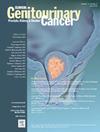The Role of miR-181a-5p and its Target Genes in the Progression of Clear Cell Renal Cell Carcinoma and Association With the Immune Microenvironment
IF 2.7
3区 医学
Q3 ONCOLOGY
引用次数: 0
Abstract
Background
Clear cell renal cell carcinoma (ccRCC) is one of the most predominant pathological types of renal cell carcinoma (RCC), with a high metastatic rate and poor prognosis. There is growing appreciation that miR-181a-5p plays a crucial role in various cancers, but the relevance of miR-181a-5p to disease progression in ccRCC and its mechanism of action in ccRCC remain poorly reported in detail. This study purposed to explore new biomarkers related to the prognosis of ccRCC and to uncover their potential mechanisms in influencing ccRCC progression.
Methods
The dbDEMC and GEO databases were used to screen differential miRNAs and differential genes in ccRCC, respectively. KEGG pathway analysis was performed to further search for differential genes in ccRCC. The miRWalk database was used to predict target genes of miR-181a-5p. The miR-181a-5p and its target genes expression, clinicopathological correlation, prognosis analysis, and immune infiltration correlation were performed in the data obtained from TCGA. STRING database was performed to construct a PPI network of the target genes of miR-181a-5p and immune-related genes of ccRCC from TISIBD database. In vitro experiments were conducted to verify the effect of miR-181a-5p on the growth, invasion and migration of ccRCC cells and to verify the target genes of miR-181a-5p.
Results
As a differential miRNA of ccRCC, miR-181a-5p is significantly up-regulated in ccRCC patients and has a high diagnostic accuracy. High expression of miR-181a-5p is related to poor progress free interval (PFI). KIT, MECOM, COL4A6, EGF, and MAPK10 are the target genes of miR-181a-5p, which are significantly down-regulated in ccRCC patients and have high diagnostic accuracy. Low expression of these genes is associated with disease progression and poor prognosis of ccRCC. In addition, miR-181a-5p and its target genes were found to be associated with the immune infiltration of ccRCC. In vitro experiments proved that miR-181a-5p promote the growth, invasion and migration of ccRCC cells, and it was found that COL4A6, EGF, and MAPK10 are more likely to be the target genes of miR-181a-5p.
Conclusions
MiR-181a-5p may work together with its target genes to affect tumor-induced immune cell infiltration, and thus affect ccRCC. MiR-181a-5p and its target genes, such as EGF and MAPK10, may be novel prognostic markers and therapeutic targets for ccRCC patients.
miR-181a-5p及其靶基因在透明细胞肾细胞癌进展中的作用及其与免疫微环境的关联
背景:透明细胞肾细胞癌(Clear cell renal cell carcinoma, ccRCC)是肾细胞癌(renal cell carcinoma, RCC)最主要的病理类型之一,转移率高,预后差。越来越多的人认识到miR-181a-5p在各种癌症中起着至关重要的作用,但miR-181a-5p与ccRCC疾病进展的相关性及其在ccRCC中的作用机制的详细报道仍然很少。本研究旨在探索与ccRCC预后相关的新生物标志物,揭示其影响ccRCC进展的潜在机制。方法:利用dbDEMC和GEO数据库分别筛选ccRCC的差异mirna和差异基因。通过KEGG通路分析进一步寻找ccRCC的差异基因。使用miRWalk数据库预测miR-181a-5p的靶基因。对TCGA获取的数据进行miR-181a-5p及其靶基因表达、临床病理相关性、预后分析、免疫浸润相关性分析。使用STRING数据库构建miR-181a-5p靶基因和TISIBD数据库中ccRCC免疫相关基因的PPI网络。通过体外实验验证miR-181a-5p对ccRCC细胞生长、侵袭和迁移的影响,验证miR-181a-5p的靶基因。结果:作为ccRCC的差异miRNA, miR-181a-5p在ccRCC患者中显著上调,具有较高的诊断准确性。miR-181a-5p高表达与PFI差有关。KIT、MECOM、COL4A6、EGF、MAPK10是miR-181a-5p的靶基因,在ccRCC患者中显著下调,具有较高的诊断准确性。这些基因的低表达与ccRCC的疾病进展和不良预后相关。此外,我们还发现miR-181a-5p及其靶基因与ccRCC的免疫浸润相关。体外实验证明miR-181a-5p促进ccRCC细胞的生长、侵袭和迁移,并发现COL4A6、EGF、MAPK10更有可能是miR-181a-5p的靶基因。结论:MiR-181a-5p可能与其靶基因一起影响肿瘤诱导的免疫细胞浸润,从而影响ccRCC。MiR-181a-5p及其靶基因,如EGF和MAPK10,可能是ccRCC患者新的预后标志物和治疗靶点。
本文章由计算机程序翻译,如有差异,请以英文原文为准。
求助全文
约1分钟内获得全文
求助全文
来源期刊

Clinical genitourinary cancer
医学-泌尿学与肾脏学
CiteScore
5.20
自引率
6.20%
发文量
201
审稿时长
54 days
期刊介绍:
Clinical Genitourinary Cancer is a peer-reviewed journal that publishes original articles describing various aspects of clinical and translational research in genitourinary cancers. Clinical Genitourinary Cancer is devoted to articles on detection, diagnosis, prevention, and treatment of genitourinary cancers. The main emphasis is on recent scientific developments in all areas related to genitourinary malignancies. Specific areas of interest include clinical research and mechanistic approaches; drug sensitivity and resistance; gene and antisense therapy; pathology, markers, and prognostic indicators; chemoprevention strategies; multimodality therapy; and integration of various approaches.
 求助内容:
求助内容: 应助结果提醒方式:
应助结果提醒方式:


